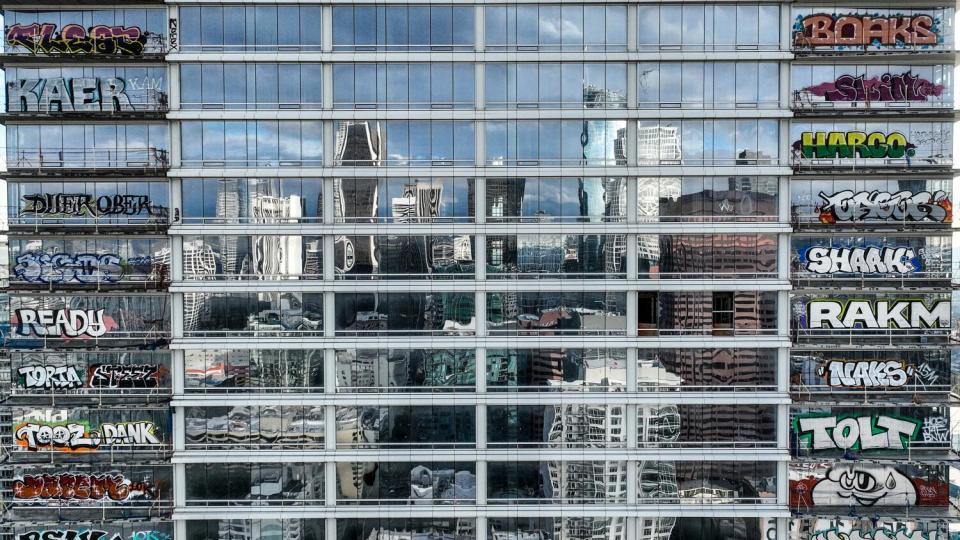Downtown L.A.'s graffiti-wrapped skyscrapers become permanent — in a tattoo
When Miguel Rodriguez approached his tattoo artist friend with an idea for an Los Angeles-themed back piece, the artist was intrigued and a little wary.
Rodriguez, 45, proposed a massive spread covering his entire back that will feature some of Los Angeles' most iconic landmarks including the 6th Street Bridge, Union Station and a surprise: Oceanwide Plaza, known more recently as the Graffiti Towers.
The towers, spanning nearly the length of Rodriguez's back, will be the largest piece of art Apple Valley tattoo artist Eric Reyna has ever tattooed on someone. The entire black and gray piece is meant to be a celebration of Los Angeles, the city where both Reyna and Rodriguez were born.
"He pushes me a lot and kind of made me do it, which I kind of love," Reyna, 31, said of the idea. "It's gonna take me a couple of sessions to finish the towers because there's so many details that go into it."
Read more: Graffiti tower debate shows Los Angeles' contradictory relationship with street culture
Rodriguez lived near the buildings for years and watched as they were transformed from abandoned skyscrapers into a multistory canvas for street art. The structures were originally part of a billion-dollar aspiration to transform a slice of downtown Los Angeles with luxury condominiums, a hotel, retailers and restaurants. Progress on the building has been stalled since 2019 when the project's Beijing-based developer ran out of money.
Earlier this year, taggers began adding their own artwork to the partially completed skyscraperthat sits directly across from Crypto.com Arena at L.A. Live. It immediately became a spectacle.
For Rodriguez, the towers are part of the fabric of Los Angeles, a place that welcomes wanderers and artists from across the country to chase their dreams.
"Those towers are iconic," Rodriguez said. "They're part of the culture of LA."

The towers, the site of several arrests and paragliding attempts, have vexed public officials who have tried to stop taggers from adding their own touches to the structures. In February, the city allocated nearly $4 million to remove graffiti and secure the property, which is now surrounded by a tall metal fence.
The graffiti sparked a lively debate among Angelenos about the line between art and vandalism. In May, the unfinished development was put up for sale.
Reyna, who owns the Ink Heart Tattoos shop with his wife Jacque Reyna, has already received some hate for the piece when he posted it on social media.
"Some people are mad about it and some people think it's the coolest tattoo .... [N]ot everyone understands the process of tattooing. I just try to be nice to them," he said.
Read more: Forget the graffiti. L.A.'s most notorious skyscrapers have a much bigger problem
Reyna's own foray into body art happened in part because of street art. His brother encouraged him to channel his artistic talent into tattooing. He started inking friends and family at home before he began doing it professionally six years ago, he said.
Reyna has already completed the bulk of two of the towers and has another to go. Stenciling the towers took Reyna six hours and the first tattoo session lasted five hours.
Rodriguez, who describes himself as having "too many tattoos to count" including a Dodgers logo on his head, isn't a novice. He sat for the last session for eight hours before he underwent surgery to repair injuries from a fall down some stairs. He has more surgeries to go and a long recovery time, but it won't stop him from getting the tattoo finished, he said.
While the future of the towers is uncertain, the structure in its current form will live on, etched onto Rodriguez's body.
It's as unique a canvas as the buildings themselves.
This story originally appeared in Los Angeles Times.


